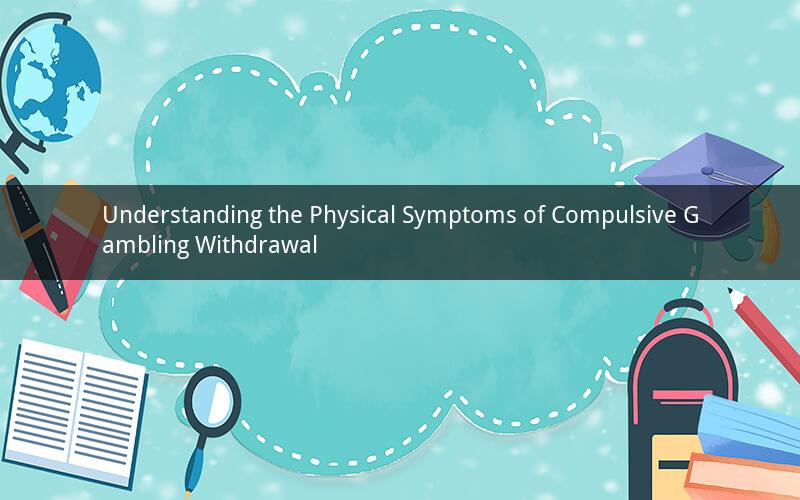
Introduction:
Compulsive gambling, often referred to as gambling addiction, is a behavioral disorder characterized by an inability to control or resist the urge to gamble. When individuals with this condition attempt to stop or reduce their gambling behavior, they may experience withdrawal symptoms. These symptoms can manifest physically, emotionally, and mentally. In this article, we will explore the physical symptoms of withdrawal from compulsive gambling.
Physical Symptoms of Withdrawal from Compulsive Gambling:
1. Anxiety and Nervousness:
One of the common physical symptoms of withdrawal from compulsive gambling is increased anxiety and nervousness. Individuals may feel restless, on edge, or irritable. They may also experience a racing heartbeat, trembling hands, or sweating. These symptoms can be quite distressing and may lead to a heightened sense of discomfort or unease.
2. Insomnia:
Another physical symptom of withdrawal from compulsive gambling is insomnia. Individuals may find it difficult to fall asleep or stay asleep throughout the night. They may experience vivid dreams or nightmares, further disrupting their sleep patterns. Insomnia can have a significant impact on overall well-being and functioning.
3. Headaches:
Headaches are a common physical symptom of withdrawal from compulsive gambling. They can range from mild to severe and may be accompanied by dizziness or blurred vision. The headaches may be attributed to stress, anxiety, or changes in sleep patterns.
4. Fatigue and Weakness:
Withdrawal from compulsive gambling can lead to feelings of fatigue and weakness. Individuals may experience a lack of energy, difficulty concentrating, and a general sense of malaise. This can impact their ability to carry out daily tasks and maintain their regular routines.
5. Digestive Issues:
Compulsive gamblers may experience digestive issues during withdrawal. These can include stomachaches, nausea, diarrhea, or constipation. The stress and anxiety associated with withdrawal can disrupt the normal functioning of the digestive system.
6. Palpitations:
Palpitations, or the sensation of a racing or pounding heartbeat, are another physical symptom of withdrawal from compulsive gambling. This can be quite distressing for individuals, as it may lead to concerns about their health or well-being.
7. Muscle Tension and Aches:
Individuals may experience muscle tension and aches during withdrawal from compulsive gambling. This can be attributed to stress, anxiety, or changes in physical activity levels. The tension may be localized to specific areas of the body, such as the neck, shoulders, or back.
8. Increased Heart Rate:
An increased heart rate is another physical symptom of withdrawal from compulsive gambling. This can be a result of anxiety, stress, or changes in hormone levels. It is important for individuals experiencing this symptom to monitor their heart rate and seek medical attention if necessary.
Conclusion:
Withdrawal from compulsive gambling can lead to a range of physical symptoms. Understanding these symptoms can help individuals seeking treatment or support for their gambling addiction. It is important to seek professional help to address both the physical and psychological aspects of withdrawal. By addressing these symptoms, individuals can improve their overall well-being and increase their chances of recovery.
Questions and Answers:
1. Q: Can physical symptoms of withdrawal from compulsive gambling be severe?
A: Yes, physical symptoms of withdrawal from compulsive gambling can range from mild to severe. Some individuals may experience intense discomfort or distress due to these symptoms.
2. Q: Are there any medications that can help alleviate physical symptoms of withdrawal from compulsive gambling?
A: While there are no specific medications designed to treat the physical symptoms of withdrawal from compulsive gambling, certain medications may be prescribed to address specific symptoms, such as anxiety or insomnia. It is important to consult with a healthcare professional for appropriate treatment options.
3. Q: Can physical symptoms of withdrawal from compulsive gambling last for a long time?
A: The duration of physical symptoms of withdrawal from compulsive gambling can vary from person to person. Some individuals may experience symptoms for a short period, while others may have ongoing symptoms for several months or even longer.
4. Q: Can physical symptoms of withdrawal from compulsive gambling lead to other health issues?
A: Yes, severe physical symptoms of withdrawal from compulsive gambling can potentially lead to other health issues. It is important to address these symptoms promptly and seek professional help to minimize any potential long-term effects.
5. Q: Can physical symptoms of withdrawal from compulsive gambling be prevented?
A: While physical symptoms of withdrawal from compulsive gambling cannot be completely prevented, individuals can take steps to minimize their occurrence. This includes seeking professional help, attending support groups, and developing healthy coping mechanisms to deal with cravings and triggers.